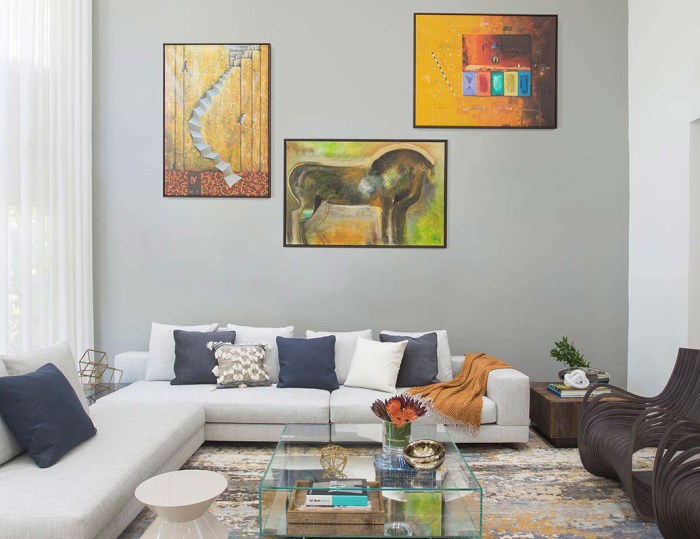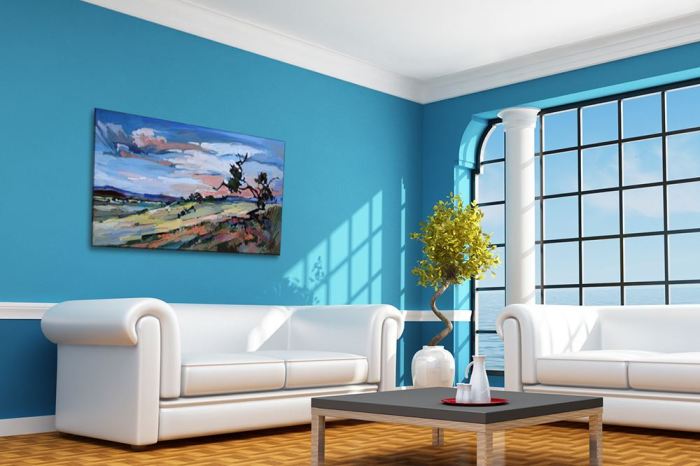Choosing the Best Interior House Paints: A Guide to Pinturas para Casa Interior
As pinturas para casa interior takes center stage, this opening passage beckons readers into a world crafted with good knowledge, ensuring a reading experience that is both absorbing and distinctly original. From exploring different types of paints to selecting the perfect color schemes, this guide covers all aspects of interior house painting.
Types of interior house paints

When it comes to painting the interior walls of your home, there are several types of paints to choose from, each with its own unique characteristics and finishes. Here are some popular options and their differences:
Matte Paint
Matte paint has a flat finish that does not reflect light, making it ideal for hiding imperfections on the walls. It provides a smooth, velvety look and is easy to touch up. Some popular brands for matte interior paints include Benjamin Moore Aura Matte and Sherwin-Williams Duration Home Matte.
Satin Paint
Satin paint has a subtle sheen that reflects light slightly, giving the walls a soft, elegant look. It is easy to clean and offers a more durable finish compared to matte paint. Popular brands for satin interior paints include Behr Premium Plus Ultra Satin Enamel and PPG Diamond Satin.
Glossy Paint
Glossy paint has a shiny finish that reflects light, creating a sleek and polished look. It is highly durable and easy to clean, making it a great choice for high-traffic areas like kitchens and bathrooms. Some popular brands for glossy interior paints include Valspar Ultra High Gloss and Glidden High Gloss.Overall, the choice between matte, satin, and glossy finishes comes down to personal preference and the desired look for your home.
Each type of paint offers different benefits and aesthetics, so it's essential to consider your needs and style before making a decision.
Choosing the right paint color for interiors
When it comes to selecting the perfect paint color for different rooms in your house, there are several factors to consider. The color you choose can greatly impact the overall feel and atmosphere of a space, so it's important to choose wisely.
Psychological Effects of Colors in Interior Spaces
Colors have the power to influence our mood, emotions, and even behavior. Here are some common psychological effects of colors in interior spaces:
- Blue: Known for its calming and serene qualities, blue is a great choice for bedrooms or living rooms where relaxation is key.
- Yellow: This bright and cheerful color can make a space feel more inviting and energizing, perfect for kitchens or dining areas.
- Green: Symbolizing nature and growth, green can create a sense of balance and harmony, making it ideal for home offices or study areas.
- Red: A bold and stimulating color, red can increase energy levels and create a sense of warmth, making it a good choice for dining rooms or social gathering spaces.
Color Schemes for Different Areas of the House
Here are some examples of color schemes that work well for different areas of the house:
| Area | Ideal Color Scheme |
|---|---|
| Bedroom | Soft neutrals like light gray, beige, or pale blue for a calming and restful atmosphere. |
| Kitchen | Bright and cheerful colors like yellow, green, or even shades of red for a lively and energetic space. |
| Home Office | Earth tones like olive green, warm brown, or deep blue to promote focus and productivity. |
| Living Room | Neutral tones with pops of color like navy blue, mustard yellow, or emerald green for a sophisticated and welcoming feel. |
Preparing the walls for painting

Properly preparing the walls before painting is crucial to achieving a smooth and long-lasting finish. Without adequate preparation, paint may not adhere properly, leading to peeling, cracking, or bubbling.
Importance of wall preparation:
- Clean walls ensure that the paint adheres properly and evenly.
- Smooth walls provide a flawless finish without imperfections showing through.
- Priming helps seal the surface, allowing the paint to bond effectively.
Steps involved in preparing walls:
- Cleaning:Remove dust, dirt, and grease using a mild detergent solution and water. Rinse thoroughly and allow to dry completely.
- Sanding:Smooth out any rough patches or bumps on the wall with sandpaper. This step helps the paint adhere better and ensures a uniform finish.
- Priming:Apply a coat of primer to seal the surface and provide a base for the paint to stick to. This step is especially important when painting over a darker color or a porous surface.
Tips on repairing cracks, holes, and imperfections on walls:
- Cracks:Use spackling compound to fill in cracks. Once dry, sand the area smooth before painting.
- Holes:Patch small holes with spackling paste. For larger holes, use a patch kit or mesh tape before applying spackling compound.
- Imperfections:Sand rough spots and imperfections on the wall to ensure a seamless finish. Use a damp cloth to wipe away any dust before painting.
Painting techniques for interior walls
When it comes to painting interior walls, there are several common techniques that you can use to achieve a professional finish. Whether you prefer brushing, rolling, or spraying, each method has its own advantages and challenges. Here are some tips to help you achieve a smooth and even finish on your walls.
Brushing
- Use high-quality brushes to avoid leaving bristles or streaks on the walls.
- Start by cutting in around the edges and corners with a brush before using a roller for the larger areas.
- Work in small sections and blend the brush strokes to create a seamless finish.
- Apply multiple thin coats rather than one thick coat to prevent drips and uneven coverage.
Rolling
- Choose the right roller nap for the type of paint and texture of your walls.
- Roll in a "W" pattern to evenly distribute the paint and avoid roller marks.
- Avoid pressing too hard on the roller to prevent excess paint from dripping or splattering.
- Overlap each pass slightly to ensure uniform coverage across the entire wall.
Spraying
- Use a paint sprayer for large, smooth surfaces to achieve a quick and even application.
- Cover surrounding areas and furniture to protect them from overspray.
- Adjust the spray pattern and pressure to control the amount and direction of the paint.
- Practice on a test surface to get a feel for the sprayer before tackling the walls.
Decorative Finishes
- For creating decorative finishes like stripes or patterns, use painter's tape to mark off the design.
- Apply a base coat in the background color and let it dry completely before adding the decorative elements.
- Use a small brush or roller to fill in the design with the contrasting color, making sure to remove the tape before the paint dries to avoid peeling.
- Experiment with different techniques like sponging, ragging, or stippling to achieve unique textures and effects on your walls.
Wrap-Up
In conclusion, pinturas para casa interior offers a world of possibilities for transforming your living spaces. By understanding the types of paints, choosing the right colors, preparing walls meticulously, and mastering painting techniques, you can create a home that truly reflects your style and personality.
Dive into the colorful realm of interior house paints and unleash your creativity today.
FAQ Insights
What are the differences between matte, satin, and glossy finishes?
Matt finishes have a flat appearance, satin finishes offer a subtle sheen, and glossy finishes are shiny and reflective.
How do I repair cracks and imperfections on walls before painting?
You can use spackling compound or joint compound to fill in cracks and holes, sand the area smooth, and then prime before painting.
What are some popular brands for interior house paints?
Popular brands include Behr, Sherwin-Williams, Benjamin Moore, and Dulux.